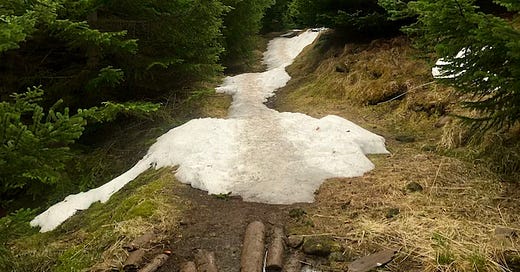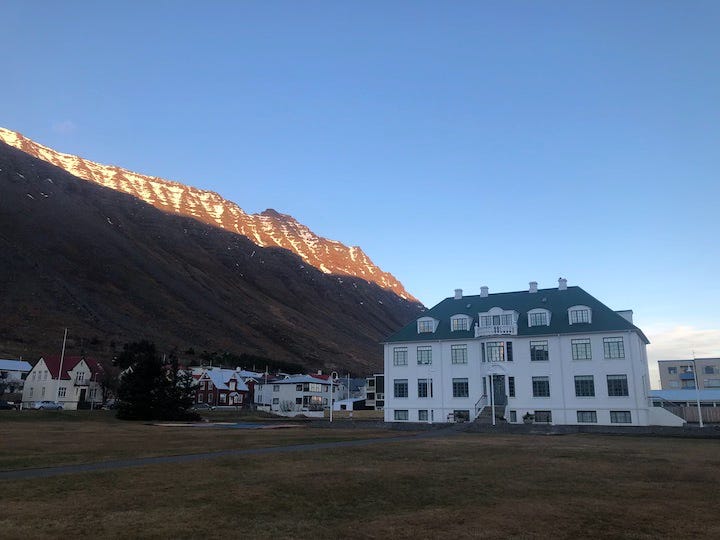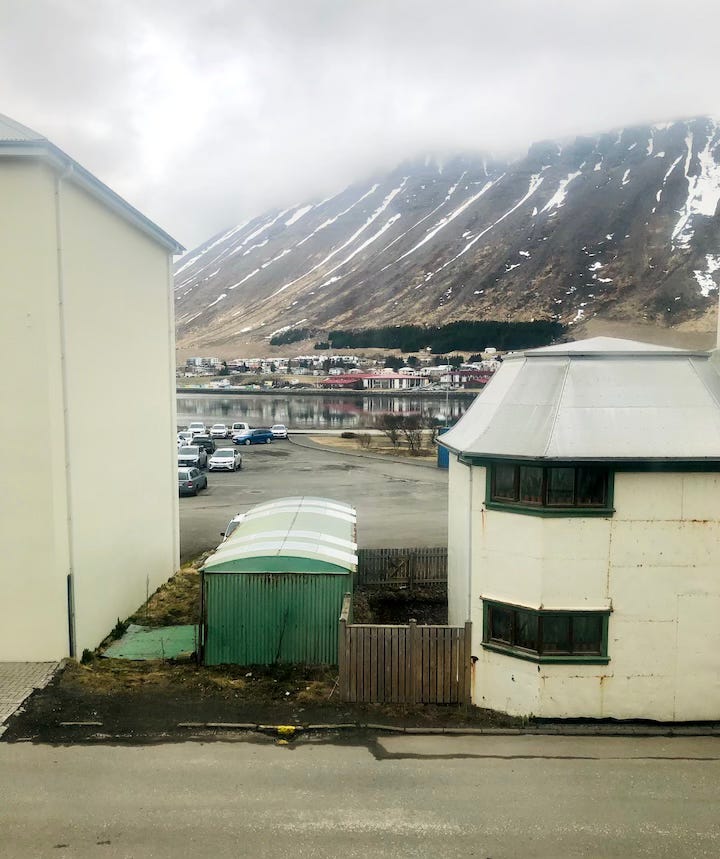I was walking down the street on my way to the library when I saw a man bend down to pick something up off the sidewalk. Not noteworthy in and of itself, but there was something about the way he did it that caught my attention. The thing he picked up appeared organic in nature—not trash but not not trash. It appeared—from where I was watching about 15 feet away—soft, somehow, almost rubbery. I watched him bring it close to his face for a better look, very close.
This happened the last time I was here in Ísafjörður, but I was reminded of it the other day walking down Hafnarstræti on my way to the library. Hafnarstræti is a short, unevenly paved street, lined with some shops and restaurants, a bakery, a post office, and a grocery store. And of course, houses and apartments, too. For a short street, it has a lot going on. Hafnar means harbours and stræti is street. While Hafnarstræti doesn’t get you all the way to the harbour, it gets you close enough. The street begins at the town square, not far from my door, and ends at the town’s one traffic circle. From square to circle, or circle to square, depending on your direction. I walk up and down Hafnarstræti every other day or so when I need to move my body for a minute but also need to keep working. I’ll walk the ten minutes or so to the library, work there for a couple hours, and then walk back to my apartment.
Ísafjörður is the largest town in the Westfjords. It has a a population of around 2600. It’s the kind of small town where within days of exploring its roughly-paved streets, shopping in the local grocery store, and walking on the mountain paths just above the town, you can get a pretty good sense of who lives here. And they can get a sense of you. During my first visit here, a woman greeted me in Icelandic as we passed one another on a mountain path. When I replied in English, she said, You must be the Canadian writer! I still have a voice recording of her on my phone teaching me how to say Góðan daginn, which means good day in Icelandic. When I arrived here two weeks ago, she was the first person I saw when I got out of my car. It’s that kind of place. Since that day on the mountain path, I try really hard to blend in while I’m here. And it mostly works. People often address me in Icelandic when they first meet me. But my blank stare always gives me away. I can get by at the grocery store: Takk fyrir. Nei takk. (Thank you. No thank you.) And almost always now when walking past someone on the street, I nod and say Góðan daginn and they say it in return. I still don’t feel confident saying gott kvöld (good evening), so after 6 PM, I remain mostly mute on the streets.
On the other side of the fjord from where I’m writing this is the main road heading out of town, above that are the houses that line the base of the mountain—and then there’s the mountain itself rising up above it all. Between these two—the houses and the steep rocky slope of the mountain—is a forest where I go walking almost every evening. I can see it all from my window right now, including the entirety of the small forest. There are not many forests in Iceland, and most of them are not very big. The largest, Hallormsstaður, which can be found in the east of the country, covers about 740 hectares (or 7.4 square kilometres). That’s big for Iceland. The Amazon Rainforest, by unfair comparison, covers about 6 million square kilometres. It’s all relative.
About 1000 years ago, it’s believed that as much as 40% of Iceland was covered by forests. Today that number is around .5%. Historians blame the Vikings and early settlers for this decimation. They needed all that wood to build homes and boats, and used what was left to fuel fires for cooking and for warmth. It took just 300 years to go from that 40% coverage to roughly where the country is at today. Any chance of significant regeneration mostly failed back then because of grazing livestock. So the blame for this mostly treeless landscape can also be placed on cows, pigs, and sheep.
All of that to say, these little pockets of forests in Iceland are pretty special, and pretty well needed.
If I’m not stopping to touch and smell everything during my walks in the small forest here in Ísafjörður, I can walk the length of it within a matter of minutes. If I’m in a different kind of mood, a sort of dilly-dallying-amateur-botanist kind of mood, it can take a long time to make my way from one end of the forest to the other. It was during that visit here a couple years ago that I first noticed the forest’s distinct smell: earthy and kind of sweet. I couldn’t quite place it, couldn’t pinpoint what the smell actually was. That is how I initially came to stop and smell everything: from the mud underfoot and the streams trickling down the side of the mountain and across the walking path, to each plant and tree and patch of moss. I would have smelled the birds, too, if I could get close enough. The forest is home to redwings, Eurasian blackbirds, crows, and the occasional raven. In the spring and summer, you can sometimes hear the distinct sound of snipes flying overhead—a winnowing buzz that is made when air rushes over their outspread tail feathers. Somewhat mysterious and alarming the first time you hear it.
The scent in the forest can be overwhelming no matter the season, but is especially so in the spring. I’ve since learned that the scent of this forest is the combination of a lot of different things: spruce, pine, birch, sweet cicely (smells and tastes like anise! Yes, I tasted it.), moss (very soft to the touch!), the mountain streams, the cold mountain air, and of course, the salty sea air. It is rich and vibrant. It smells in such a way that it reminds me every single time just how forceful and capable the sense of smell is when it comes to transporting you to another time or place—whether into the past or just into your imagination. Depending on the day, it can also have the opposite effect: it can ground you right in the moment, and in such a way that convinces you there is no where else in the world you’d rather be. It smells that good.
Unless I’m in the forest or walking on the mountain paths, I normally walk rather fast. I don’t know why. It’s not like I’m in a hurry to get anywhere. Back on Hafnarstræti, where I saw the man stop to pick up something off the sidewalk, I slowed my pace right down because there was something about his movements that intrigued me. I have a tendency to smile broadly when something intrigues me, when I’m enthralled. It’s a little embarrassing because I’m usually not aware of it when it’s happening. When I’m alone, no problem, but when people are around and I suddenly start grinning, I fear that I must look like a creep. When I see people walking down the street alone and smiling, I often think to myself: What the hell are you smiling about? Unless I’m also smiling. Then I nod in recognition and whisper: Isn’t life beautiful?
I was smiling while I watched that man examine whatever it was he had picked up. I slowly stepped closer until what he was examining came into view. It was a mouse. A small, ash-grey, long-tailed and very dead mouse. He brought it right up to his face then, and sniffed it. And then sniffed it again. I stopped walking at this point because I needed to see how this played out.
The man held the mouse by its tail, the tip of it pinched between his thumb and index finger, and he continued to scrutinize it. I was loving every moment of this. I mean, how often do you get to see something like that? Was he a field naturalist taking his work to the streets? A veterinarian? An animal rights activist? Was this some kind of local job I wasn’t aware of? When he was done inspecting the mouse—he spent a good couple of minutes on it—he carried it over to the nearest garbage can and just as he was about to toss it in, he noticed me watching.
I smiled—even more broadly somehow—and nodded my head. I was trying, with that nod, to impart some kind of understanding, like: I get it! I am also interested in tiny things and the cycle of life and the absolute wonder of the natural world. And I also smell things! I was smelling things on the side of the mountain just this morning! Isn’t life beautiful?
What I got in return was a frown. He was clearly not pleased with me having witnessed this… scene. Perhaps he was embarrassed. I smiled an even bigger smile. I was trying to project warmth, comradery, and understanding. I was trying to let him know that I wasn’t there to judge. But this only made things worse, and the man frowned more deeply.
After tossing the mouse in the garbage, he walked over to where I was standing. I tried to rein in my smile. He stopped and stood in front of me, close—very close—and he said with the utmost seriousness: We will never speak of this again.
I could feel my mouth wanting to curve back into a wider grin, a grin of joyful wonder. I thought he was doing a bit. I thought he’d start to laugh, and we’d talk about the mouse, about how it smelled. I thought maybe we’d become pals and this would be our meet-cute and we would in fact speak of it again. It’d be a story we’d tell at parties. But it wasn’t a bit. He was dead serious.
Not to get into the weeds of the semantics of what he had said, but we hadn’t spoken of it at all. Not yet, anyway. I didn’t point that out but I wanted to. Also, did he mean that he and I would never speak of it again? Because I was willing to agree to that. Or did he mean that I personally should never speak of it? Because if that’s what he meant, I would have told him that wouldn’t be possible. I’m sorry, I would have said, but I can tell you right now that I’m going to be talking about this for a while. But I didn’t say any of that. I slowly disassembled my smile, and offered him one simple, obedient, and respectful nod. Yes, okay then, we shall never speak of this again.
He spoke to me in English, though he was clearly Icelandic. He knew I was not from here. I had somehow blown my cover. I thought I was blending in, but I wasn’t. Would a local have walked by without acknowledging the scene? (I’d like to see them try!) Would a local have not made eye contact with a man sniffing a dead mouse on the sidewalk? Would they have minded their own goddamn business? I don’t have the answers to any of that. But what I do know is that I would stop and watch that scene play out again and again. And also, I have not stopped speaking of it since that day.






I am SO glad you wrote about it;